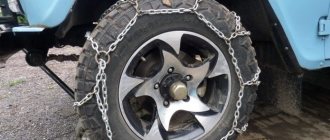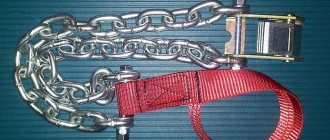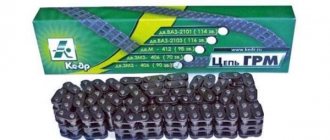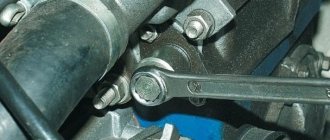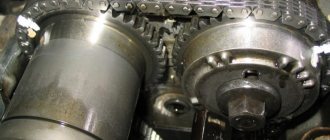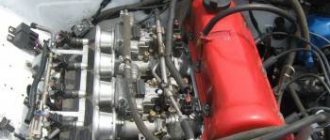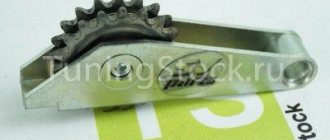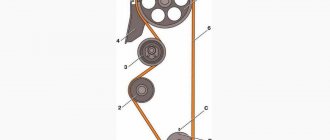The timing chain plays an important role in the operation of the gas distribution mechanism. Over time, it stretches and requires tension, since the quality of the engine depends on it. Therefore, you need to know when to check the tension and how to tension the chain on a VAZ 2101. This topic is covered in an article and a video that demonstrates the process of checking and tensioning the chain drive.
When is stretching necessary?
Chain tensioning is required in the following cases:
- after engine repair;
- after replacing the product;
- when stretched after prolonged use.
Timing belt VAZ 2101
In the first two cases, it is clear that checking the tension is necessary, since the chain was removed or replaced. In addition, you should also check that the alignment marks match. These marks are located on the crankshaft and camshaft. You can determine the need for tension by the sounds of the engine running. If the tension is weak, then during its operation extraneous noises are heard in the place where the chain drive is located. At the same time, timing parts wear out faster. Therefore, when checking the tension, it is necessary to pay attention to the condition of the damper and the shoe.
Timing tensioner shoe
If the tension is weak, the links can jump several teeth, then the valve timing will be disrupted. In this case, the car may stall, not start, and the speed will fluctuate. You can use a flathead screwdriver to check. It needs to be inserted and, using as a lever, pressed on the chain. It should not bend and be stretched like an arrow. Do not put too much pressure on the drive, although the part is metal, it is subject to deformation.
The video below looks at a VAZ 2101 car, in which a clattering sound is heard when the engine is running. It shows in detail how to check the condition of the damper, the shoe, and how to carry out tension.
Step-by-step instruction
Before starting troubleshooting, check that all timing components are free of mechanical defects. To do this, you need to remove the protective cover of the drive and perform a visual inspection of the parts: sprockets, damper, tensioner and shoe. If defects are found, these components should be replaced.
Tools
Before you start work, you need to prepare the necessary tools:
- keys to “13” and “38”;
- flat screwdriver;
- pliers.
To carry out work, the car should be placed on a convenient platform and supports should be placed under the wheels so that it does not roll. The gear shift lever must be set to neutral.
Engine compartment of VAZ 2101
Stages
- First you need to find the tensioning device; it is located under the pipes near the pump. Use the key to “13” to release the tensioner. Once the chain is loosened, the shoe should pop off.
- Next, you should take the key at “38” and throw it on the crankshaft pulley nut. Then you need to turn the crankshaft a couple of turns in a clockwise direction.
- Rotate the shaft until the marks on the camshaft sprocket and on the camshaft bearing housing coincide. In this case, the spring located inside the tensioning device, acting on the shoe, will automatically perform the necessary tension.
- It is advisable to additionally check the tension using a screwdriver. If everything is normal, then we return to the tensioner and tighten its head with a wrench.
Checking tension with a screwdriver
After tightening the chain drive, you should start the engine and check its operation. It should work without extraneous noise. If the noise remains after tensioning, then the reason may be in the damper. Then you need to check its serviceability and replace it if necessary. It may not be possible to tension the chain drive the first time, so this procedure will have to be repeated several times.
During the procedure, it is necessary to ensure that the marks match so that the valve timing does not go astray.
This operation should be carried out every time after any repair work. In addition, a preventive check should be performed after the 10 thousand kilometers mark. If you learn how to check and tension yourself, this will make it possible to extend its service life and save on car service costs.
Keep it up!
Keep it up!
Along with the advent of overhead engines, a simple and reliable timing chain drive was introduced. But there are some drawbacks - the chain and sprockets gradually wear out, the drive makes more and more noise, notifying the owner of the need for intervention. There are known engine designs where the tension of the timing chain is not adjusted at all - when certain wear occurs, the chain is simply replaced. This can hardly be considered a gift - replacement is expensive! Most developers prefer a different approach: for good engine operation throughout the entire run, it is desirable to keep the chain tension as stable as possible. Moreover, we are talking here not only about the averaged indicator, but also about circuit oscillations that need to be smoothed out. As a result of design searches, two necessary devices were born - a chain tensioner and a chain vibration damper.
There are two main types of tensioners - hydraulic and mechanical. The first ones on domestic cars have not proven to be reliable, but the dangers of weakening the chain are known. Engine operation is accompanied by various vibrations - in particular, a sagging chain whips against the sprockets and breaks the damper. Once free, she can jump over the teeth; and the impacts of the pistons on the valves complete the picture of the accident. It’s not for nothing that many people abandon hydraulics in favor of simple mechanics.
One of such devices is the VAZ-2101 chain tensioner. Structurally, it is quite complex, although it is not automatic. The chain must be tightened periodically. In addition, he is not without “sores”. It happens that when struck by a chain, the rod is recessed, slips in the collet clamp, and there is little spring force for reverse movement. If the length of a worn chain is already at its limit, then this tensioner (even a working one!) does not help - there is not enough rod travel. After all, the maximum distance from its end to the flange is only 68 mm. And then the pacifier breaks. Therefore, some craftsmen, without waiting for trouble, put an extension cord on the rod.
Modern tensioners are automatic. I installed one like this, the chain tightened - and you can forget about it for a long time.
Some of the RODOS tensioners we showed are intended to replace outdated devices on any Zhiguli cars. Thanks to the solid overhang of the rod, they are also suitable for the VAZ-21213 engine; A tensioner was also created for the Niva VAZ-21214 engine instead of the standard hydraulic tensioner, about which there are complaints. In addition, RODOS supplies a set of two original tensioners of hydromechanical action (oil pressure to help the spring) for the ZMZ-405 and 406 engines - again, instead of the standard hydraulic ones.
From the point of view of a repairman, the tensioners of this company have one drawback: it is often necessary to loosen the chain tension, and with RODOS this is not easy. It is almost impossible to recess the rod and secure it with a pin without removing the tensioner. Yes, and it won’t work right away on film. It's also a little confusing. the grace of the notch on the rail. The small step is designed to make the tensioner operation almost stepless, but the requirements for the quality of the material must be very strict - after all, the unit restrains strong vibrations! What happens if there is a small glitch in technology? How will the openwork design of the rod behave in the event of a breakage of the stop on the tensioner shoe, which is commonplace for VAZ engines, and an “oblique” load on the heel of the rod? This is especially true for the 21214 motor: the extended rod increases the leverage of the force.
We hope that time will dispel these fears. In the meantime, the RHODS product attracts many with its good performance and, taking into account the large circulation, its low price (about 350 rubles).
ISAI tensioners are quite rare on the market, which is explained by the lower production capacity of the manufacturer. Price - about 400 rubles. We were attracted to them by the simplicity and high rigidity of the design without “openwork” parts, stepless regulation and ease of operation during repairs. Tensioners are intended for engines of “classic” VAZ, “Niva” VAZ-21213 and 21214 and for some ZMZ. As for the latter, the ISAI developer took into account the difficult operating conditions of timing chains, especially the upper ones, due to lack of lubrication. For these motors, tensioners have been created that are installed instead of hydraulic ones, and they provide additional oil supply (for this purpose a groove is made on the body) directly to the chains. The service life of the drives is significantly increased.
The operating conditions of the circuit cannot be called simple. Due to wear on the hinge joints, its length and pitch gradually increase - and the chain no longer fits correctly on the sprockets. Another problem is that the chain does not wear out quite evenly - the reason is not only the variation in the properties of the material, but also the different loading of the links in different areas. There are several factors. The number of teeth on sprockets and links should ideally not be multiples. But, alas... For example, on a “penny” a chain of 114 links works on a timing sprocket with 38 teeth - the multiplicity is three. This means that, under certain conditions, increased wear of individual sections of the chain is possible (imagine the constant repetition of “meetings” of more loaded teeth with the corresponding links). After all, the valve mechanism itself loads the chain unevenly (ZR, 2001, No. 3) - the forces of the valve springs either accelerate or slow down the chain, exciting its oscillations. The motorist is dealing with the “end result” - during operation, the chain can hit the sprockets, and this must be avoided! The tensioner and damper come into play. The first directly limits the freedom of the chain, which means the amplitude of oscillations. The second dampens oscillations that intensify for any reason, preventing resonance from developing. Both devices are equally important for long and trouble-free operation of the motor.
The most famous automatic tensioner on the market today is from RODOS. The principle of operation is very simple (Fig. a): rod 4, reminiscent of a rack, extends under the action of a calibrated spring 1 - the longer the chain, the more. The spring-loaded pawl 3 prevents the rod from moving back under the influence of chain vibrations. The mechanism is supplied for sale in a cocked state (see Fig. b) - the locating pin 2 is secured with a “pin” 5 through the holes. Having placed the device on the engine, the pin is removed - and the rod will extend, tensioning the chain. The maximum distance from the flange to the stem heel is 73 mm. This guarantees sufficient tension even on a heavily worn chain and sometimes saves you from disaster if the guide is broken.
A fundamentally new product on the tensioner market is ISAI. In terms of connecting dimensions and maximum rod output (73 mm), it is identical to RHODES. The design is very rigid (Fig. a), the rod 1 extends due to rotation in the M14x2.0 thread of the housing 2. And the rotation is set by a calibrated spring 4 of the clock type, connected at one end to the housing, the other to the axis of the drive 3. In the cocked state (a ) the mechanism is held by a clamp 6 under a cap 5. The clamp is a piece of soft wire, etc. Having placed the tensioner on the engine, screw off the cap - the chain will tighten (Fig. b). After removing the retainer, screw the cap back on to prevent oil leakage. If you need to loosen the chain, you don’t need to remove the tensioner—screw off the cap, use a screwdriver to rotate the shank counterclockwise, cocking the spring—the rod is recessed. By pressing it with the chain shoe, we fix it from turning, then we put the lock in the protective cap and screw it on. The tensioner will remain in this position.
Video “Timing chain tension on classics”
This video demonstrates how to tension a chain in a classic VAZ.
Welcome! Chain tensioner - don’t know what it is? Before you start replacing, we advise you to read a short article about the tensioner, in which everything about it will be described in detail. (See “What is a chain tensioner for?”)
Note! To replace the tensioner, stock up on: A basic set of wrenches, and if you have it, you can also use a “13” spanner!
Question? Which brand of chain tensioner will you install on your car and why did you choose it? (Write your answer in the comments)
When should you change the timing chain tensioner? It must be replaced if:
- The car began to operate unstably, or if various sounds appeared in the area where the timing chain is located.
Note! If you want to know what sounds the engine will make if the chain tensioner is faulty, then in this case, start the video at the very end and watch its beginning, and you will understand everything!
- The tensioner also needs to be replaced if it no longer holds the chain in a tense state due to the fact that it has become deformed.
Note! You can also try adjusting the timing chain! (For information on how to adjust the timing chain, see the article “Adjusting the timing chain on the VAZ 2101-VAZ 2107”)
Installation of damper VAZ 2107
Installation of the damper is carried out in the reverse order. In this case, you should tension the chain and check the positions of the marks on the camshaft and crankshaft of the engine.
The seats of the damper mounting bolts must be lubricated with sealant. This will prevent oil from seeping through.
Sometimes a car enthusiast encounters extraneous sounds that come from the area of the front engine cover and resemble a kind of tapping. This may be a sign that the chain guide needs to be replaced. The damper on the VAZ 2107 model is necessary to soften the vibrations of the chain during its rotation. If you can clearly hear a clattering or metallic tapping sound, this means that the damper is very worn and needs to be urgently replaced. Another possible cause of the problem is that the chain tension is too loose. In this car model, the damper is located on the left, in front of the cylinder block. Use the diagram supplied with the machine to determine the exact location of the part to be replaced.
Dismantling the timing belt on a VAZ 2106
Timing belt with chain drive on VAZ 2101
The “kopek”, like all other “classic” models, has a timing chain drive. The mechanism consists of a double-row metal chain and additional elements that ensure its tension and prevent vibrations. The well-coordinated operation of the motor directly depends on the integrity and serviceability of each part of the mechanism. The chain drive connects the crankshaft and camshaft and ensures their synchronous operation. When the shafts rotate, the pistons in the engine cylinders are set in motion, and the valves in the cylinder head (cylinder head) open and close in a timely manner.
Tranquilizer
The damper performs the function of damping circuit vibrations. Without it, the chain may jump or fly off the sprockets of the timing mechanism. If the damper breaks down, the drive may simply break off. Such a nuisance is possible at high engine speeds. If the chain breaks, the pistons and valves are damaged, requiring expensive repairs. Therefore, the condition of the damper must be monitored and replaced in a timely manner. The part is a durable metal plate with special holes for fastening.
Opposite the damper there is a shoe, which is also responsible for calming and tensioning the chain. It is made of a special polymer material, which gives the part high wear resistance.
Tensioner
The “penny” chain drive tensioner prevents the chain from loosening when the motor is running. The element comes in several types:
- auto;
- mechanical;
- hydraulic.
Automatic tensioners began to be produced recently, but with regard to this part, it is already possible to note the pros and cons. The main positive point is that there is no need to make periodic adjustments, i.e. the drive is constantly in tension. The disadvantages include fairly quick failure and high cost of the part. In addition, based on reviews from car enthusiasts, the auto tensioner does not tension the chain very well.
The operation of hydraulic devices is based on the supply of oil under pressure from the engine lubrication system. With this design, the driver does not need to worry about periodically tightening the chain. However, over time, the part may malfunction, which manifests itself in the form of jamming of the mechanism.
The VAZ classic uses a mechanical tensioner. The part has a significant drawback: over time, it becomes clogged with small particles, the plunger jams and the device loses its ability to produce tension.
One of the key elements of the timing chain drive is the chain itself, made of metal and having a certain number of links: on the VAZ 2101 there are 114 of them. Compared to a belt drive, the chain is more reliable and has a longer service life.
Depending on the quality of the chain and the operating conditions of the vehicle, it is replaced every 60–100 thousand km. There are cases that a part lasts for 200 thousand km, but it’s hardly worth the risk, because a broken chain will result in a much more expensive repair than its timely replacement.
The chain is tightened every 10 thousand km, even in the absence of signs indicating sagging.
Typical chain tensioner defects
Such malfunctions include:
- A collet-type clamp is not able to fix the product rod, which interferes with adjustment work on the correct tension of the chain drive.
- Wear of the main spring element (looks like this: the spring element is deformed in one plane, which becomes noticeable after dismantling the chain tensioner, which shines on one side).
- Damper spring failure.
- Limit wear of the product rod at the point where the collet-type clamp is attached.
- Defects in threaded connections on the installation fasteners (studs) of the product.
Chain mechanism fault detection
The timing drive, equipped with a chain, is structurally located inside the engine. To determine the condition of the parts of this mechanism, it is necessary to partially disassemble the motor. The fact that there are problems with the chain or drive elements is indicated by characteristic signs.
The chain is noisy
A circuit can have different types of noise:
- noise under load;
- knocking on a warm engine;
- extraneous sounds when cold;
- constant noise with a metallic character.
If the motor begins to make sounds that are uncharacteristic of its normal operation, it is necessary to find out as soon as possible what problems have arisen with the chain drive and eliminate them. If this is not done, wear on the timing drive elements will increase, which can lead to costly repairs.
Video: chain knocking in a VAZ “classic” engine
Timing drive components may fail prematurely for the following reasons:
- the use of oil not specified by the car factory, or its untimely replacement;
- use of low-quality parts;
- low lubricant pressure in the engine;
- failure to comply with engine maintenance regulations;
- low quality of repairs.
Often the chain is noisy due to stretching or problems with the tensioner. Attempts to tighten it turn out to be useless, and the engine sounds like a diesel engine. The sound most often appears on a cold engine when idling.
Jumped the chain
With high mileage of the vehicle, the timing chain stretches. As a result, it can simply jump to other teeth of the camshaft or crankshaft gears. This problem may occur when the timing drive parts are damaged. If the chain jumps by at least one tooth, the ignition is greatly shifted and engine operation becomes unstable (sneezes, shoots, etc.). To fix the problem, you will need to check the integrity of the parts, and if damage is detected, make repairs.
Timing chain repair VAZ 2101
On the first model Zhiguli, the timing chain drive consists of several elements, the condition of which determines the operation of the entire mechanism as a whole. If any of these parts fail, repairs must be carried out immediately. Let's look at the step-by-step steps for replacing the timing drive components on a “penny”.
Replacing the damper
Before you begin repairs, you need to take care of preparing the appropriate tools and materials. You will need:
- screwdrivers;
- a set of keys;
- new chain guide;
- wire hook.
After preparing everything necessary, we begin the repair in this order:
- After unscrewing the fasteners, remove the air filter box.
Replacing the tensioner
The chain tension device on the “classic” is located in the cylinder head below the cooling system pipe above the pump. To replace the part, use the same tools as for repair work with the damper, but you will additionally need a wrench to turn the crankshaft. Actions boil down to the following steps:
- Using a 10 mm wrench, unscrew the tensioner fastener to the cylinder head.
Replacing the shoe
The shoe is changed with the same tools as when working with the damper. Repairs are carried out as follows:
- Remove the engine sump protection plate.
Chain replacement
The chain on the “penny” is changed with the following tools:
- hammer;
- screwdrivers;
- spanners;
- mounting blade;
- a piece of wire;
- key for turning the crankshaft.
After preparation, we proceed to disassembly:
- We repeat the steps to replace the damper up to point 6 and the shoe up to point 8 inclusive.
- Rotate the crankshaft until the mark on the camshaft sprocket aligns with the protrusion on its housing. The mark on the crankshaft should be positioned opposite the mark on the timing cover.
The chain drive is installed in the following order:
- We put the chain on the crankshaft sprocket and on the gear of the auxiliary devices.
Video: how to change the chain on a “classic”
Installing the chain by marks
The need to install marks on the timing mechanism may arise during the repair process or when the chain is severely stretched. If the marks do not match, the stable operation of the motor is disrupted due to a phase shift. In this case, an adjustment is required. The work is carried out with the following tools:
- Screwdriver Set;
- key for rotating the crankshaft;
- a set of keys.
We carry out the procedure according to the following instructions:
- We dismantle the air filter box and the valve cover with the seal by unscrewing the fasteners.
- Loosen the tensioner clamp, press the screwdriver against the shoe and tighten the nut.
- Using a 38 mm wrench or a crank, turn the crankshaft until the marks on its pulley and the timing cover match, and the mark on the camshaft sprocket should be located opposite the protrusion cast on the body.
- If any of the marks do not coincide, turn on the fourth speed and unbend the lock washer on the camshaft sprocket.
- We unscrew the bolt and remove the gear.
- Remove the chain from the sprocket and set the desired position (step 3). After installing the marks, we perform reverse assembly.
Video: how to set timing marks on classic Zhiguli cars
Adjusting chain tension
The need to tighten the chain may be necessary in different situations:
- engine repair;
- replacing the chain drive;
- chain stretching.
To work you will need the following tools:
- 13 and 38 mm keys;
- flat screwdriver;
- pliers.
Tensioning the chain consists of several steps:
- We place the car on a flat surface, turn on neutral, placing stops under the wheels.
- We unscrew the chain tensioner clamp, and a characteristic click will be heard.
- Use a 38 mm wrench to rotate the crankshaft, making several revolutions.
- Stop rotation at maximum force and tighten the tensioner nut.
If the valve cover is removed, you can determine the tension of the chain by pressing it with a screwdriver . If the chain is tensioned normally, it will be stiff.
Automatic chain tensioner
Recently, as an alternative, an automatic chain tensioner has been used in the gas distribution mechanisms of such vehicles, which operates according to the following principle. The hydraulics of the system operate under the pressure of the motor lubrication and help to maintain the required tension mode of the chain drives in the required position, at which the need to manually install the VAZ 2106 chain tensioner practically disappears.
In the body of the chain tensioner, the price of which is slightly more expensive, there is an oil hole, coaxially located with the analogue in the power plant block. In the internal cavity of the body part of the product there is an adapter device with a ball, which is under high pressure, regulated by a pressure-reducing valve. Using a threaded plunger device, the automatic chain tensioner is able to control the functionality of the drive chain in any situation, even when the engine is turned off.

